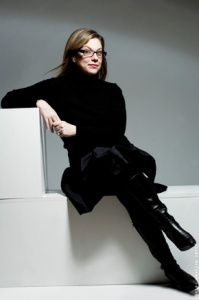Installment number 4 brings us a perspective from New York branding expert, Debbie Millman, President of the design division at Sterling Brands.
Debbie Millman has worked in the design business for over 25 years. She is President of the design division at Sterling Brands. She has been there for 17 years and in that time she has worked on the redesign of over 200 global brands.
Debbie is President Emeritus of the AIGA, the largest professional association for design. She is a contributing editor at Print Magazine, a design writer at FastCompany.com and Chair of the Masters in Branding Program at the School of Visual Arts in New York City. In 2005, she began hosting the first weekly radio talk show about design on the Internet. The show is titled “Design Matters with Debbie Millman” and it is now featured on DesignObserver.com. In 2011, the show was awarded a Cooper-Hewitt National Design Award.
Debbie is the author of five books on design including “Brand Thinking and Other Noble Pursuits,” (Allworth Press, 2011), “Look Both Ways: Illustrated Essays on the Intersection of Life and Design,” (HOW Books, 2009) and “How To Think Like A Great Graphic Designer” (Allworth Press, 2007).
1. In today’s packaging, how much emphasis is placed on form and how much on graphics? Is one more dominant than the other?
Structure is a critical component in a brand’s chain of experiences and is as important as graphics. I think that they are equally important and both as intertwined with the overall experience and engagement with a brand. When considering structural opportunities for brands, I would recommend considering the following:
- Form & shape = meaning & definition
- Surprising materials can add an additional emotional connection
- A signature silhouette can enhance own-ability and recognition
- An inventive, alluring structure can solve critical issues at retail – pilferage, shop-ability, SKU distinction, storage and preservation
- A unique structure can add consumer value, i.e. portability, serving control, security
- A proprietary structure can telegraph product benefit and can help differentiate from a sea of assimilated competitors
2. Has the focus on sustainability in packaging leveled off or will it continue to rise?
As long as packaging contributes to landfills, I believe that no only will the focus on sustainability continue to rise, it will become a mandate for all manufacturers, distributors and designers brands. There are a slew of recent and exciting new eco-trends developing in the packaging industry that will hopefully be embraced en masse by the owners of consumer brands. By switching to soy-based inks on product packaging, beefing up recycling incentives and showing off recycled attributes, or even reevaluating and reintroducing an eco-minded brand mission and communicating it through packaging, brands can send smaller eco-friendly messages to a much larger and participatory audience.
3. With the growing number of products entering the market, what are the expectations of companies in regards to sales performance based on package design and do you feel they are realistic?
Companies give package design agencies money to redesign their products in an effort to increase sales, consumer engagement and trial. Period. Corporations have a right to expect that they will get a return on their investment when a redesign hits market. However, most package design initiatives are part of a much bigger branding initiative that includes advertising, social, digital, in-store, direct marketing, and so forth. As a result, it is difficult to evaluate how any one of those isolated efforts may be contributing to the overall success of any integrated effort. It is not impossible, but it is really expensive and the data is not always reliable or statistically significant. Ironically, the additional spend only increases the delta between money spent and ROI.
4. Do you find budgets for package design growing or shrinking?
Budgets really depend on the client. I have found that our big clients have an expectation that you will be able to service their business globally and, therefore, the fees are commensurate with the scale of the initiative. But I’m seeing smaller clients’ budgets shrinking, mostly because of the risk inherent in bringing a new brand to market, especially if they are spending their own money.
5. When designing a package, how connected are you to the manufacturing and fulfillment segments?
Again, this depends on the client. Traditional canned goods or products in standard structures do not require as much manufacturing or fulfillment for a package designer. But create a new structure or begin using a new substrate and you must, must, must work with manufacturing and fulfillment or you are doomed and will lose a ton of money.
6. How often have you bought a product based on the package?
More often than I could ever count.
7. Have you ever purposely designed a package to have a life (or use) past the product it contains?
No.
8. Many consumers complain about clamshell packaging due to the difficulty in opening one. Since that feature is in place to deal with theft, how would you counter or improve that part of the clamshell design?
Better in-store security systems and stronger law enforcement.
: )
9. What package would you like to design?
I’d love to riff on the iconic, classic orange and brown Hermes box. But can you imagine? If people didn’t like it, my career would be over.
10. What is your favorite package?
My all-time favorite package is Mattel’s late 1970s packaging for the Perfume Liddle Kiddle Doll. In fact, it is currently on display in my office.

